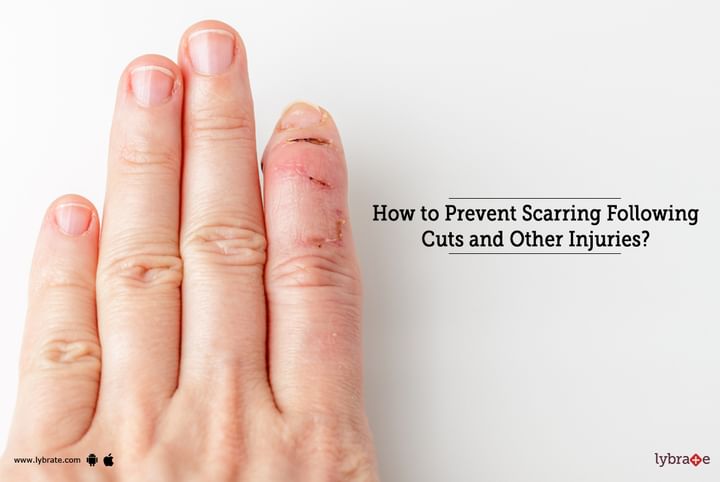Get the App
For Doctors
Login/Sign-up
Last Updated: Mar 14, 2023
BookMark
Report
How to Prevent Scarring Following Cuts and Other Injuries?
What is Skin scarring?
Skin scarring is a condition in which the skin loses its normal texture and appearance, replacing it with a fibrotic tissue called scar tissue. Commonly caused by injury or deep acne lesions, skin scarring results in permanent changes to the skin that may affect its color, texture, and function.
What are the signs and symptoms of Skin scarring?
- Visible markings on the skin: Skin scarring presents as a visible mark on the skin due to increased collagen production. Some of these marks can appear raised, sunken, discolored, and textured differently than the surrounding healthy skin.
- Itchiness: People with newly formed scars may experience itchiness in the affected area, which usually fades over time as the wound heals itself.
- Sensitivity to touch: Newly formed scars can be extremely sensitive to touch and can cause pain when touched or rubbed.
- Drying out of skin: People are also likely to experience an extremely dry patch of skin where their scar is located due to lack of proper moisture retention from the underlying scar tissue or lack of protective layers of skin in that area (such as hair follicles). This can lead to discomfort and irritation for those affected by this condition.
- Discoloration: Scars typically appear red or pink when they first form which gradually fades over time into white or grayish hues depending on pigmentation levels present in that person’s natural complexion.
What are possible complications of Skin scarring?
Skin scarring can cause a number of physical and psychological complications, including:
- Increased sensitivity to sunlight, leading to an increased risk of sunburns.
- The appearance of a visible scar on the skin permanently.
- Loss of the normal texture and colour of the skin.
- Unpleasant itching sensation which can result in further damage to the scarred area if scratched excessively.
- A decrease in self esteem due to feeling uncomfortable with one’s physical appearance.
- Embarrassment as a result of having visible scars on body parts exposed to others ( face, arms etc).
- Increased risk for infection at the site of the scar due to weakened tissue from any scratching or trauma from clothing or objects rubbing against the site.
How to Prevent Scarring Following Cuts and Other Injuries?
- Moisturize the skin regularly: Use a natural, thick, and noncomedogenic moisturizer to keep the skin hydrated to reduce chances of scarring. Look for ingredients such as aloe vera, olive oil, almond oil, jojoba oil and shea butter.
- Keep the wound clean: Wounds left untreated can increase the risk of scarring. Therefore, it’s best to keep a clean wound bandaged and monitored by your doctor or dermatologist for signs of infection or scarring.
- Apply sunscreen: Sun exposure can irritate existing wounds and increase scarring potential. Use sunscreen with an SPF of at least 25 when outside to protect your skin from UV radiation-induced damage that could lead to excessive scarring.
- Try Ayurvedic home remedies: Ayurveda offers many remedies for reducing scars including making a paste from water and a few teaspoons each of sandalwood powder and turmeric powder or creating special steam treatments with medicinal herbs like fenugreek seeds - boil them in water until their skins start changing color – strain out solids then add 4-5 drops of tea tree essential oil before inhaling deeply while covering your head with a towel over the pot to create an herbal steam facial that may reduce the appearance of scars over time.
- Take supplements: Zinc can help support healthy wound healing but be sure to ask your doctor about taking any supplement as it could interfere with any existing medical conditions you may have or medications that you are taking currently before starting any types of supplementation regimen.
If non-medical treatments fail to alleviate your symptoms, you may have to resort to surgical intervention.
What are the surgical treatments for Skin scarring?
- Chemical Peel: A chemical peel is a form of treatment that involves using a variety of chemicals to exfoliate the top layers of skin and help reduce the appearance of skin scarring. This method uses chemical solutions such as salicylic acid, glycolic acid, or trichloroacetic acid, which are applied directly to the scarred area to break down the skin’s top layer. The area can then be treated with moisturizers and other products that can accelerate healing and reduce visibility of scars.
- Laser Skin Resurfacing: This type of treatment utilizes laser energy to treat unwanted scars on the surface level. All laser types are used for this process; however, ablative lasers work best for deep scarring or tissue damage from injury or surgery. With this method, there is no downtime involved and its effects can last up to two years after treatment has been completed.
- Dermabrasion: Dermabrasion is a form of physical exfoliation in which an abrasive device is used over the affected area in order to remove scar tissue as well as lessen its appearance over time. The affected region should be applied with local anesthesia before undergoing this procedure in order make it less uncomfortable during application
Best doctors to consult for Skin scarring
- Dermatologists: Dermatologists are highly trained medical doctors who specialize in medical and surgical skin care, including the prevention, diagnosis, and treatment of a wide variety of skin-related conditions. These doctors can accurately diagnose a variety of skin conditions such as acne, eczema, melasma, psoriasis, rosacea and other chronic inflammatory skin disorders. They can also provide expert advice on how to prevent further scarring related to a skin condition and provide effective treatments to minimize existing scarring.
- Cosmetic Surgeons: Cosmetic surgeons specialize in cosmetic procedures such as laser resurfacing to reduce the appearance of acne scars or burn scars and chemical peels for mild to moderate texture irregularities in the face and neck area. If you have deep surgical scars or other severe forms of scarring, a cosmetic surgeon can often help improve their appearance with specialized techniques including dermabrasion or microdermabrasion.
- Plastic Surgeons: Plastic surgeons are expertly trained medical professionals who specialize in treating patients with facial plastic surgery treatments such as face lifts or rhinoplasty. In addition to these facial aesthetic procedures, they may also perform scar revision procedures when necessary if you have deep indentations from previous injuries or surgeries which make your current aesthetic more challenging than it should be grafted with tissue from another area for smoothing out indentations commonly known as 'scar grafting'.
- Dermatopathologists: Dermatopathology is an important specialty that focuses on diagnosing abnormalities found within anatomic structures associated with the skin such as tumor cells from cancerous tumors. This specialty is particularly beneficial when it comes to identifying pre-cancerous conditions which often leads to early detection helping significantly reduce the risk of developing cancerous tumors which could lead to significant disfigurement through surgical removal or radiation treatment required for eliminating these growths which tend often cause significant scarring afterwards.
In case you have a concern or query you can always consult a specialist & get answers to your questions!



+1.svg)
